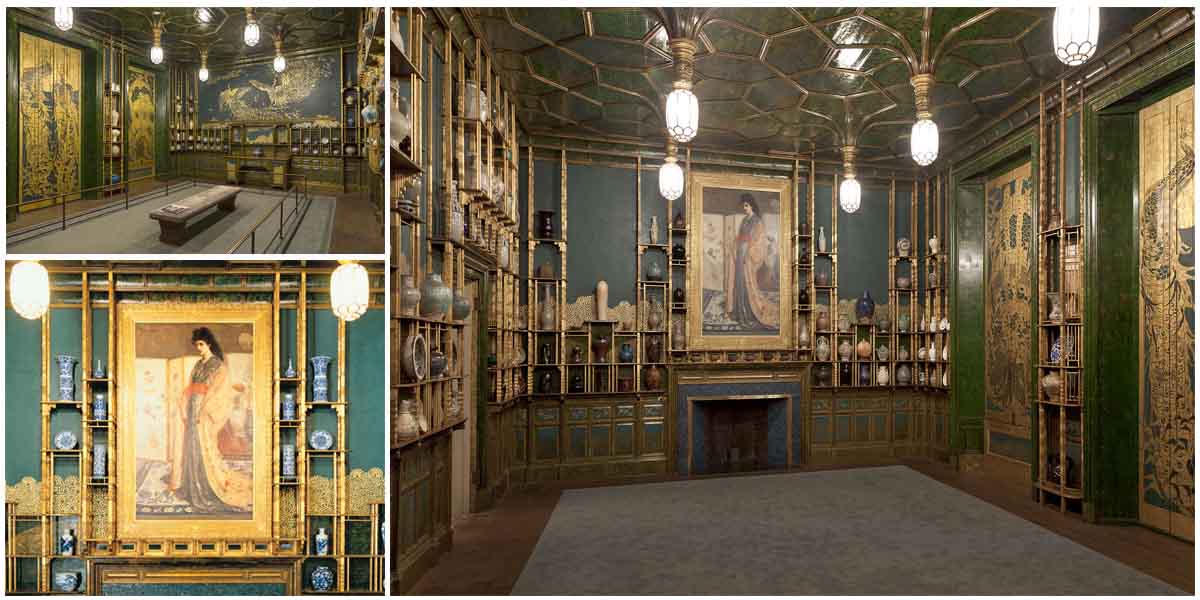The Peacock Room, now in a Washington, D.C. museum, was originally a dining room in the mansion owned by wealthy shipowner Frederick Leyland in London. It contained a masterpiece of mural art created by James Abbott McNeill Whistler. “The Peacock Room, permanently on display in the Freer Gallery of Art, is widely regarded as the most important nineteenth century interior in an American museum,” wrote art historian Linda Merrill and author of The Whistler Room: A Cultural Biography.
The room also embodies one of the most divisive relationships known between any patron and artist.
The architect who designed the room was Thomas Jeckyll, who had asked for help from Whistler, then 42 years old, in deciding on the colors, the doors, and the shutters. Whistler and Leyland were already known to each other, Leyland being a patron of artists, not only Whistler but also Edward Burne-Jones and Dante Gabriel Rossetti. But Whistler was a gifted artist who was combative, arrogant, and self-obsessed. He would later write The Gentle Art of Making Enemies to take on his critics and settle some scores.
Jeckyll commissioned Whistler to paint the room in blue-green with over-glazing gold leaf. In 1876, after Leyland had to leave the city, Whistler took the liberty of adding to the room. (Jeckyll’s illness forced the architect to step away from the project.) Whistler later wrote: “Well, you know, I just painted on.”
By the time the owner returned, the room had been decorated with some not-so-minor flourishes. The entire surface of the room was painted in various shades of blue, green, and gold. One of the most important pieces in the chamber is the painting Rose and Silver: The Princess from the Land of Porcelain, which was made by Whistler between 1863 and 1865. Currently, the painting hangs in the center of the room of the Freer Gallery.
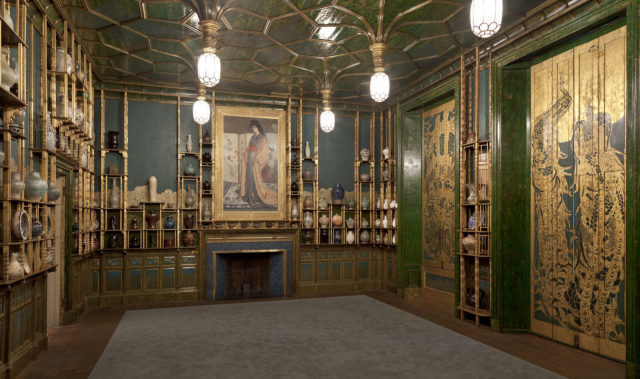
The princess in the picture is a stunning Western woman wearing a kimono. The background is filled with numerous Asian objects such as a rug, screen, and some porcelain vases. The model for the painting was Christine Spartali, who was a favorite among the artists of the period. The Anglo-Greek beauty was particularly admired by the impressionist artists.
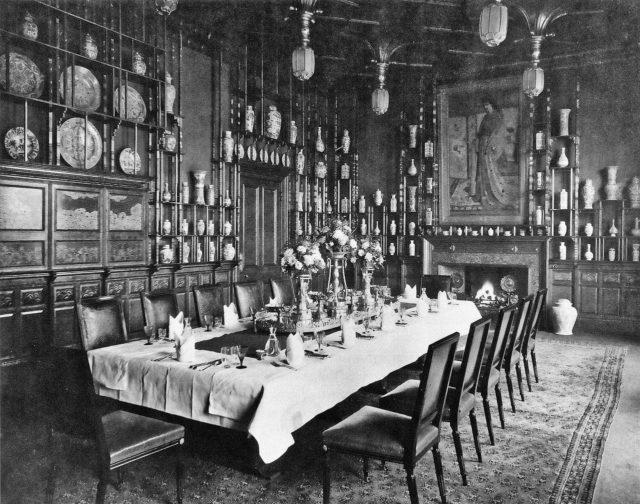
Because Leyland was so “surprised” by the degree to which Whistler artistically expressed himself and by the amount of money that he demanded for his work, he removed Whistler from the project. Leyland was deeply unhappy, and they argued about the work and its cost for a long time. At one point, Whistler entered Leyland’s home and fearlessly painted two fighting peacocks, giving the piece the title Art and Money: or, The Story of the Room.
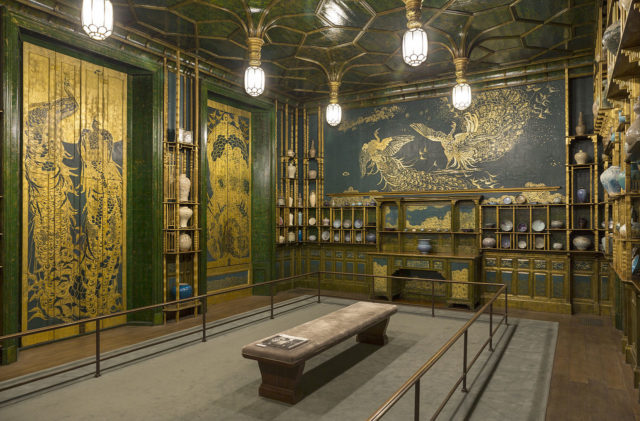
One of the birds represents Leyland as a proud peacock that is entirely made of money, and the poor peacock on the left side of the painting, which it appears to be running away from, is presumably the artist. During some of their quarreling, the artist said to his patron that he made him famous and he would only ever be known as the owner of the Peacock Room, but Whistler would be remembered forever.
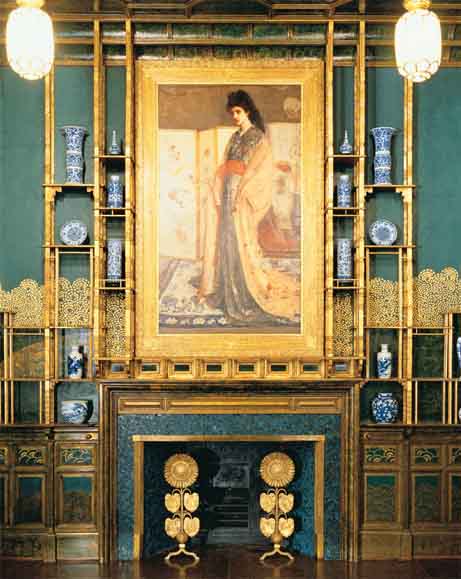
The disagreements continued. In 1879, Whistler filed for bankruptcy and Leyland was his chief creditor at that point. When people came to his home to liquidate his property, they were surprised by another piece, this time it was called The Gold Scab: Eruption in Filthy Lucre or The Creditor, depicting a caricature of Leyland sitting above Whistler’s house in anthropomorphic demonic peacock form playing the piano. The piece was painted in the same colors that he used for the Peacock Room.
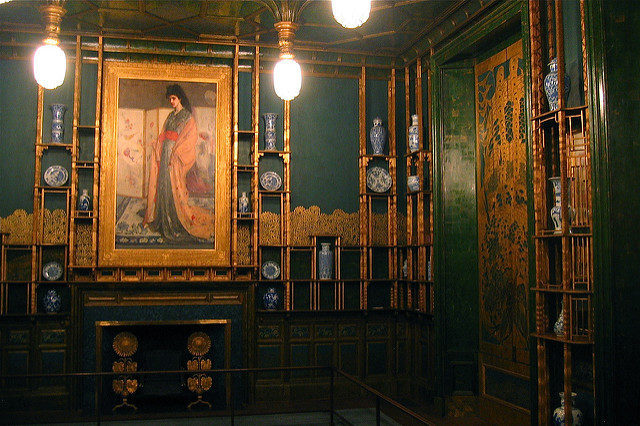
Whistler mentioned the drama in The Gentle Art of Making Enemies: “Woe is me! I secreted, in the provincial shipowner’s home, the ‘noble bird with wings expanded.’ ” A complication to their feud: Whistler had painted a stunning portrait of Leyland’s beautiful wife, and the husband was convinced the two were having an affair. Leyland wrote to Whistler: “It is clear that I cannot expect from you the ordinary conduct of a gentleman. If I find you in her society again I will publicly horsewhip you.” The final touch in this drama was the architect’s Jeckyll’s reaction. After he recovered his physical health and saw what Whistler had done to the room, he lost his grip on his sanity and died three years later.
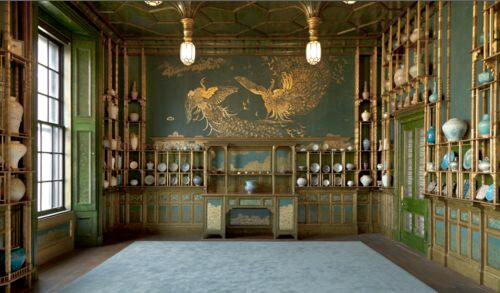
Perhaps surprisingly, considering the animosity that existed between Whistler and Leyland, the room always remained as it was when finished. Leyland dined every day facing the two fighting peacocks until his death.
In 1904, the room was purchased by Charles Lang Freer. It was carefully removed from the mansion and moved to Freer’s home in Detroit. During his life, Freer filled the room with various ceramics from all over Asia. It was later conveyed to Washington, D.C. The Freer and the Arthur M. Sackler Gallery are the Smithsonian’s national museums of Asian art.
